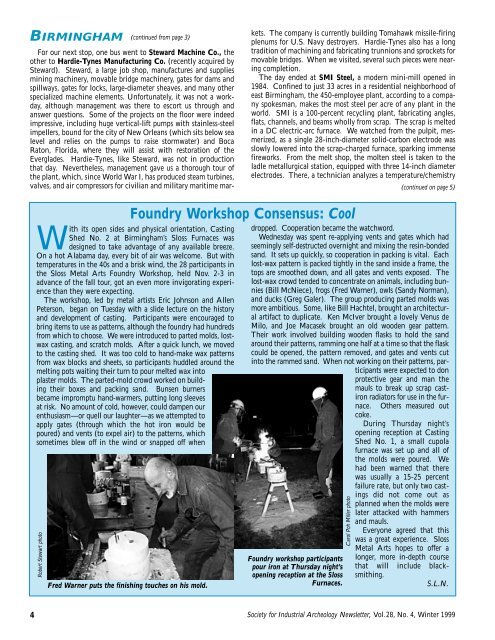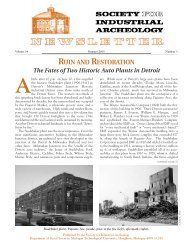birmingham, “pittsburgh of the south,” - Society for Industrial ...
birmingham, “pittsburgh of the south,” - Society for Industrial ...
birmingham, “pittsburgh of the south,” - Society for Industrial ...
You also want an ePaper? Increase the reach of your titles
YUMPU automatically turns print PDFs into web optimized ePapers that Google loves.
BIRMINGHAM (continued from page 3)<br />
For our next stop, one bus went to Steward Machine Co., <strong>the</strong><br />
o<strong>the</strong>r to Hardie-Tynes Manufacturing Co. (recently acquired by<br />
Steward). Steward, a large job shop, manufactures and supplies<br />
mining machinery, movable bridge machinery, gates <strong>for</strong> dams and<br />
spillways, gates <strong>for</strong> locks, large-diameter sheaves, and many o<strong>the</strong>r<br />
specialized machine elements. Un<strong>for</strong>tunately, it was not a workday,<br />
although management was <strong>the</strong>re to escort us through and<br />
answer questions. Some <strong>of</strong> <strong>the</strong> projects on <strong>the</strong> floor were indeed<br />
impressive, including huge vertical-lift pumps with stainless-steel<br />
impellers, bound <strong>for</strong> <strong>the</strong> city <strong>of</strong> New Orleans (which sits below sea<br />
level and relies on <strong>the</strong> pumps to raise stormwater) and Boca<br />
Raton, Florida, where <strong>the</strong>y will assist with restoration <strong>of</strong> <strong>the</strong><br />
Everglades. Hardie-Tynes, like Steward, was not in production<br />
that day. Never<strong>the</strong>less, management gave us a thorough tour <strong>of</strong><br />
<strong>the</strong> plant, which, since World War I, has produced steam turbines,<br />
valves, and air compressors <strong>for</strong> civilian and military maritime mar-<br />
With its open sides and physical orientation, Casting<br />
Shed No. 2 at Birmingham’s Sloss Furnaces was<br />
designed to take advantage <strong>of</strong> any available breeze.<br />
On a hot Alabama day, every bit <strong>of</strong> air was welcome. But with<br />
temperatures in <strong>the</strong> 40s and a brisk wind, <strong>the</strong> 28 participants in<br />
<strong>the</strong> Sloss Metal Arts Foundry Workshop, held Nov. 2-3 in<br />
advance <strong>of</strong> <strong>the</strong> fall tour, got an even more invigorating experience<br />
than <strong>the</strong>y were expecting.<br />
The workshop, led by metal artists Eric Johnson and Allen<br />
Peterson, began on Tuesday with a slide lecture on <strong>the</strong> history<br />
and development <strong>of</strong> casting. Participants were encouraged to<br />
bring items to use as patterns, although <strong>the</strong> foundry had hundreds<br />
from which to choose. We were introduced to parted molds, lostwax<br />
casting, and scratch molds. After a quick lunch, we moved<br />
to <strong>the</strong> casting shed. It was too cold to hand-make wax patterns<br />
from wax blocks and sheets, so participants huddled around <strong>the</strong><br />
melting pots waiting <strong>the</strong>ir turn to pour melted wax into<br />
plaster molds. The parted-mold crowd worked on building<br />
<strong>the</strong>ir boxes and packing sand. Bunsen burners<br />
became impromptu hand-warmers, putting long sleeves<br />
at risk. No amount <strong>of</strong> cold, however, could dampen our<br />
enthusiasm—or quell our laughter—as we attempted to<br />
apply gates (through which <strong>the</strong> hot iron would be<br />
poured) and vents (to expel air) to <strong>the</strong> patterns, which<br />
sometimes blew <strong>of</strong>f in <strong>the</strong> wind or snapped <strong>of</strong>f when<br />
Robert Stewart photo<br />
Fred Warner puts <strong>the</strong> finishing touches on his mold.<br />
kets. The company is currently building Tomahawk missile-firing<br />
plenums <strong>for</strong> U.S. Navy destroyers. Hardie-Tynes also has a long<br />
tradition <strong>of</strong> machining and fabricating trunnions and sprockets <strong>for</strong><br />
movable bridges. When we visited, several such pieces were nearing<br />
completion.<br />
The day ended at SMI Steel, a modern mini-mill opened in<br />
1984. Confined to just 33 acres in a residential neighborhood <strong>of</strong><br />
east Birmingham, <strong>the</strong> 450-employee plant, according to a company<br />
spokesman, makes <strong>the</strong> most steel per acre <strong>of</strong> any plant in <strong>the</strong><br />
world. SMI is a 100-percent recycling plant, fabricating angles,<br />
flats, channels, and beams wholly from scrap. The scrap is melted<br />
in a DC electric-arc furnace. We watched from <strong>the</strong> pulpit, mesmerized,<br />
as a single 28-inch-diameter solid-carbon electrode was<br />
slowly lowered into <strong>the</strong> scrap-charged furnace, sparking immense<br />
fireworks. From <strong>the</strong> melt shop, <strong>the</strong> molten steel is taken to <strong>the</strong><br />
ladle metallurgical station, equipped with three 14-inch diameter<br />
electrodes. There, a technician analyzes a temperature/chemistry<br />
Foundry Workshop Consensus: Cool<br />
dropped. Cooperation became <strong>the</strong> watchword.<br />
Wednesday was spent re-applying vents and gates which had<br />
seemingly self-destructed overnight and mixing <strong>the</strong> resin-bonded<br />
sand. It sets up quickly, so cooperation in packing is vital. Each<br />
lost-wax pattern is packed tightly in <strong>the</strong> sand inside a frame, <strong>the</strong><br />
tops are smoo<strong>the</strong>d down, and all gates and vents exposed. The<br />
lost-wax crowd tended to concentrate on animals, including bunnies<br />
(Bill McNiece), frogs (Fred Warner), owls (Sandy Norman),<br />
and ducks (Greg Galer). The group producing parted molds was<br />
more ambitious. Some, like Bill Hachtel, brought an architectural<br />
artifact to duplicate. Ken McIver brought a lovely Venus de<br />
Milo, and Joe Macasek brought an old wooden gear pattern.<br />
Their work involved building wooden flasks to hold <strong>the</strong> sand<br />
around <strong>the</strong>ir patterns, ramming one half at a time so that <strong>the</strong> flask<br />
could be opened, <strong>the</strong> pattern removed, and gates and vents cut<br />
into <strong>the</strong> rammed sand. When not working on <strong>the</strong>ir patterns, participants<br />
were expected to don<br />
protective gear and man <strong>the</strong><br />
mauls to break up scrap castiron<br />
radiators <strong>for</strong> use in <strong>the</strong> furnace.<br />
O<strong>the</strong>rs measured out<br />
coke.<br />
During Thursday night’s<br />
opening reception at Casting<br />
Shed No. 1, a small cupola<br />
furnace was set up and all <strong>of</strong><br />
<strong>the</strong> molds were poured. We<br />
had been warned that <strong>the</strong>re<br />
was usually a 15-25 percent<br />
failure rate, but only two castings<br />
did not come out as<br />
planned when <strong>the</strong> molds were<br />
later attacked with hammers<br />
and mauls.<br />
Everyone agreed that this<br />
Foundry workshop participants<br />
pour iron at Thursday night’s<br />
opening reception at <strong>the</strong> Sloss<br />
Furnaces.<br />
was a great experience. Sloss<br />
Metal Arts hopes to <strong>of</strong>fer a<br />
longer, more in-depth course<br />
that will include blacksmithing.<br />
S.L.N.<br />
4 <strong>Society</strong> <strong>for</strong> <strong>Industrial</strong> Archeology Newsletter, Vol.28, No. 4, Winter 1999<br />
Carol Poh Miller photo<br />
(continued on page 5)






